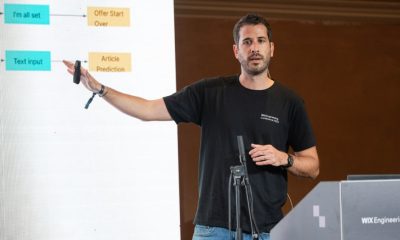Interviews
Chris Joynt, Director Product Marketing at Securiti AI – Interview Series

Chris Joynt, Director Product Marketing at Securiti AI, has spent more than 15 years working in data and AI, wearing many hats from sales to solutions and now product marketing. This broad experience informs his perspective on the current moment in AI. His journey includes selling Big Data with IBM, growing an AutoML startup before delving into ML in IoT and streaming data platforms. Chris is now championing AI security and governance at Securiti AI.
A veteran of the “great data wars”, Chris loves making complex tech understandable and valuable by turning complex concepts into compelling stories. Beyond tech, he’s a devoted father and coaches both Muay Thai and soccer.
In my journey through the great data wars, I have developed a basic principle that I apply to technology, and it almost always works. That is, whenever a hot new innovation comes along that appears to be the solution we’ve been hoping for, it doesn’t automatically give us the outcome we’re hoping for. It solves one key problem, yes, but then as we rush to adopt this tech, we all find out that the “hard part” just moved somewhere else.
For example, when Hadoop and NoSQL came along, organizations could store massive amounts of unstructured data. But then everyone discovered the “hard part” had moved from storing massive amounts of data to “how am I going to build applications and tools that can USE this data?” When AutoML commoditized model building, the hard part became properly representing a business problem with structured data, and so on, and so on.
Right now, AI technology is incredibly hot and for good reason – it has great transformative potential. But the new hard part is how do I put the right controls in place so that I can harness my proprietary data safely? If AI can crawl through every file in an instant, how do I ensure that I don’t expose sensitive data? Securiti AI started building the solution long before anyone else realized that the hard part of enterprise AI would be operationalizing data and AI intelligence and security.
For readers who may not be familiar, how would you describe Securiti AI’s core focus on AI Trust, Risk, and Security Management (TRiSM), and why is this becoming such a critical category?
AI TRiSM, short for Trust, Risk, and Security Management. AI is such a powerful class of technology that promises tremendous rewards but also carries risk. Compliance issues, brand damage, data leakage, or cyber vulnerabilities can completely derail AI momentum. TRiSM is about addressing those risks proactively to accelerate AI adoption securely and sustainably by developing a strategic capability to control AI systems and build trust. Trust is what drives AI adoption. What’s brilliant about the TRiSM model is that it’s a layered model where foundational capabilities are then built upon.
TRiSM prescribes information governance as that foundation supporting the runtime guardrails layer and ultimately visibility and governance. Securiti AI maps very cleanly onto this model and supports AI TRiSM with a layered approach that prioritizes information governance and data security, which in turn enables our runtime guardrails to be more effective. Our runtime guardrails help create visibility for the governance layer, where we can test these controls against regulatory and best practices frameworks, so we have assurances that data is safe.
Securiti AI’s approach to TRiSM improves security posture, reducing the risk of sensitive data leakage, protecting brand reputation and IP, gaining better insight into AI usage, and enabling the safe reuse of AI assets.
M&A deals expose organizations to massive data risks. How does Securiti’s platform specifically help companies spot and neutralize these risks before, during, and after integration?
Securiti AI automatically scans and maps data across both merging entities, identifying sensitive information, hidden “dark data,” and redundant or risky datasets. This visibility allows organizations to spot issues early, enforce data access controls, and minimize data liabilities after the M&A transaction.
By automating discovery and classification, Securiti AI ensures ROT (Redundant, Obsolete, Trivial) data is addressed and all critical intellectual property, regulated personal data, and any data that poses a significant privacy or security risk are protected. The result is a faster, safer, and more compliant transition through every phase of the transaction.
Securiti often talks about enabling a “governance transition team.” How does the company’s technology support collaboration between IT, legal, and compliance groups in these high-pressure scenarios?
Securiti AI’s Data+AI Command Center creates a single source of truth for data and risk, so IT, legal, and compliance teams aren’t working from disconnected spreadsheets and assumptions. Visualizing the relationships between data, users, systems, and policies as data flows across systems helps drive a more intuitive understanding of risk and gives a common language to these stakeholders. Having a single platform from which I can see risk, refine and enforce policy, and push remediations into my data systems enables cross-functional teams to be very effective.
What role does AI play inside Securiti’s solutions—particularly in areas like mapping sensitive data, automating identity controls, or detecting compliance risks?
AI is core to how we operationalize data intelligence and security. The Data+AI Command Center automatically discovers and classifies sensitive data using AI. This gives our customers confidence that no sensitive data is lurking in files that we didn’t find. Our AI firewalls (or guardrails) also use AI to detect sensitive data, harmful content, or malicious instructions in prompts and responses that could compromise compliance, while our retrieval firewall enforces data access controls against source data even when AI is querying on a user’s behalf.
Using AI helps our customers to scale their governance of data and AI systems, ensuring they remain in control as their environments grow ever more complex.
Many companies struggle with redundant, obsolete, and trivial (ROT) data. How does Securiti help organizations reduce their data footprint while improving security posture and lowering cost?
ROT data is a ticking time bomb that drives up storage costs, creates compliance risks, and expands the attack surface. With Securiti AI’s Data+AI Command Center, organizations can automatically discover shadow and native data across multi-cloud and SaaS environments, centralize inventory, and flag redundant or obsolete files based on age, activity, or duplication. Securiti AI then classifies sensitive data to identify retention violations and apply federated auto-remediation policies to securely delete or quarantine ROT data. This level of automation lowers costs, strengthens compliance with global regulations like GDPR and CPRA, and shrinks the attack surface.
What differentiates Securiti AI from other players in the security and governance space, especially as enterprises evaluate TRiSM solutions?
Unlike tools that address fragments of the AI and data security problem, Securiti AI unifies data security, privacy, compliance, and AI governance into one platform. Our Data+AI Command Center, powered by graph technology, gives enterprises a connected view of their data, risks, entitlements, and AI activity across hybrid environments.
This foundation allows us to do three things that set us apart. First, we provide baseline intelligence by discovering models, automatically classifying sensitive data, preserving file-level permissions, and mapping the entire data and AI estate. Second, we deliver real-time AI protections, monitoring prompts, retrieval, inferences, and outputs to block leakage, poisoning, and other attacks. Third, we offer top-down visibility and control, continuously testing data and AI assets against regulatory frameworks and automating compliance reporting.
The result is a holistic TRiSM solution that not only protects enterprises from AI risk but also accelerates safe deployment at scale. Customers tell us the breadth of coverage, automation, and usability across security, compliance, and business teams is what sets Securiti AI apart.
The pace of regulatory change is accelerating worldwide. How does Securiti help customers stay ahead of new compliance requirements during complex transactions?
The Data+AI Command Center continuously maps data to regulatory obligations across global and national U.S. jurisdictions, so enterprises can see exactly where compliance gaps may arise. During high-stakes events like M&A, we automate controls and reporting to help customers stay aligned with evolving laws without slowing the deal.
Beyond M&A, where else are customers using Securiti’s AI security solutions today—for example, in cloud migrations, divestitures, or AI model governance?
Customers use our AI security solutions to detect shadow AI, map data and AI usage, deploy permissions-aware enterprise AI assistants, curate sanitized datasets for training and fine-tuning, secure RAG system vulnerabilities, enforce guardrails to protect sensitive data and users, prevent prompt injection and other attacks, and generate reports for compliance and risk management.
Looking ahead, where do you see Securiti AI positioned in the next three to five years, and how do you envision the company shaping the future of AI trust and data security?
Securiti AI is very well-positioned right now. AI will continue integrating and embedding deeper into processes and experiences. The ability to protect users and data and ensure that AI can be trusted will be a strategic capability. The contextual intelligence Securiti AI extracts through classification and graphing will grow increasingly valuable as AI agents gain greater autonomy, decision-making power, and access to tools and data. I believe that in three to five years, multi-agent systems will be able to tackle complex processes, but their success will hinge upon the ability of the organization deploying them to manage data context with sophisticated access controls and guardrails to deliver trust in those systems.
Thank you for the great interview, readers who wish to learn more should visit Securiti AI.












